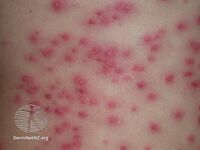Hot tub folliculitis
| Hot tub folliculitis | |
|---|---|
| Other names: Pseudomonas aeruginosa folliculitis | |
 | |
| Pseudomonas folliculitis, also known as hot tub folliculitis | |
Hot tub folliculitis (pseudomonal folliculitis) is a common type of folliculitis, a condition which causes inflammation of hair follicles.[1]
This condition is caused by an infection of hair follicles by a non-pathogenic strain of the bacterium Pseudomonas aeruginosa. The bacterium is commonly found in hot tubs, water slides, and rarely in swimming pools. Children are more prone because they typically stay in the water longer than adults.[citation needed] Hot tub folliculitis appears on the skin in the form of a rash, roughly resembling chicken pox and then develops further to appear as a pimple.[2]
Normally, the rash does not need specific treatment and will go away on its own.[3] Antibiotics may be prescribed in some cases. If the rash continues to appear longer than the 7- to 10-day time period, a physician should be consulted. Folliculitis that is not treated properly could worsen and cause abscesses.[citation needed]
-
Pseudomonas folliculitis
Signs and symptoms
Hot tub folliculitis can be extremely painful and/or itchy, and left alone without scratching will go away much more quickly. If the rash is aggravated, it can stay, worsen, and spread, lasting for months. By that time, it is much more difficult to treat. In an immunocompetent person, the rash is self-limited and will usually resolve after about 7 to 10 days but the condition can leave a hyperpigmented lesion that goes away after a few months.[citation needed]
See also
References
- ↑ James, William D.; Elston, Dirk; Treat, James R.; Rosenbach, Misha A.; Neuhaus, Isaac (2020). "14. Bacterial infections". Andrews' Diseases of the Skin: Clinical Dermatology (13th ed.). Edinburgh: Elsevier. p. 270. ISBN 978-0-323-54753-6. Archived from the original on 2023-06-30. Retrieved 2023-06-01.
- ↑ "Swimmer's Itch and Hot Tub Folliculitis". Advanced Dermatology. May 23, 2019. Archived from the original on November 27, 2020. Retrieved November 19, 2020.
- ↑ Goodheart, Herbert P. (2010). Goodheart's same-site differential diagnosis : a rapid method of diagnosing and treating common skin diseases. Philadelphia, Pa.: Lippincott Williams & Wilkins. p. 296. ISBN 978-1605477466.
| Classification |
|---|
- Pages with script errors
- All articles with unsourced statements
- Articles with unsourced statements from February 2015
- Articles with invalid date parameter in template
- Articles with unsourced statements from January 2016
- Articles with unsourced statements from May 2021
- Bacterium-related cutaneous conditions
